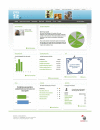An Internet-based intervention to promote mental fitness for mildly depressed adults: randomized controlled trial
- PMID: 24041479
- PMCID: PMC3929047
- DOI: 10.2196/jmir.2603
An Internet-based intervention to promote mental fitness for mildly depressed adults: randomized controlled trial
Abstract
Background: Depression is a worldwide problem warranting global solutions to tackle it. Enhancing well-being has benefits in its own right and could be a good strategy for preventing depression. Providing well-being interventions via the Internet may have synergetic effects.
Objective: Psyfit ("mental fitness online") is a fully automated self-help intervention to improve well-being based on positive psychology. This study examines the clinical effects of this intervention.
Methods: We conducted a 2-armed randomized controlled trial that compared the effects of access to Psyfit for 2 months (n=143) to a waiting-list control condition (n=141). Mild to moderately depressed adults in the general population seeking self-help were recruited. Primary outcome was well-being measured by Mental Health Continuum-Short Form (MHC-SF) and WHO Well-being Index (WHO-5); secondary outcomes were depressive symptoms, anxiety, vitality, and general health measured by Center for Epidemiological Studies Depression Scale (CES-D), Hospital Anxiety and Depression Scale Anxiety subscale (HADS-A), and Medical Outcomes Study-Short Form (MOS-SF) vitality and general health subscales, respectively. Online measurements were taken at baseline, 2 months, and 6 months after baseline.
Results: The dropout rate was 37.8% in the Psyfit group and 22.7% in the control group. At 2-month follow-up, Psyfit tended to be more effective in enhancing well-being (nonsignificantly for MHC-SF: Cohen's d=0.27, P=.06; significantly for WHO-5: Cohen's d=0.31, P=.01), compared to the waiting-list control group. For the secondary outcomes, small but significant effects were found for general health (Cohen's d=0.14, P=.01), vitality (d=0.22, P=.02), anxiety symptoms (Cohen's d=0.32, P=.001), and depressive symptoms (Cohen's d=0.36, P=.02). At 6-month follow-up, there were no significant effects on well-being (MHC-SF: Cohen's d=0.01, P=.90; WHO-5: Cohen's d=0.26, P=.11), whereas depressive symptoms (Cohen's d=0.35, P=.02) and anxiety symptoms (Cohen's d=0.35, P=.001) were still significantly reduced compared to the control group. There was no clear dose-response relationship between adherence and effectiveness, although some significant differences appeared across most outcomes in favor of those completing at least 1 lesson in the intervention.
Conclusions: This study shows that an online well-being intervention can effectively enhance well-being (at least in the short-term and for 1 well-being measure) and can help to reduce anxiety and depression symptoms. Further research should focus on increasing adherence and motivation, reaching and serving lower-educated people, and widening the target group to include people with different levels of depressive symptoms.
Trial registration: Netherlands Trial Register (NTR) number: NTR2126; http://www.trialregister.nl/trialreg/admin/rctview.asp?TC=2126 (archived by WebCite at http://www.webcitation.org/6IIiVrLcO).
Keywords: Internet; depression; prevention; public health; randomized controlled trial; well-being.
Conflict of interest statement
Conflicts of Interest: Trimbos Institute is the developer of Psyfit and has a share in the social venture that implements the intervention. Neither the authors working at the Trimbos Institute nor the institute itself derive financial income from the interventions.
Figures
References
-
- Bromet E, Andrade LH, Hwang I, Sampson NA, Alonso J, de Girolamo G, de Graaf R, Demyttenaere K, Hu C, Iwata N, Karam AN, Kaur J, Kostyuchenko S, Lépine JP, Levinson D, Matschinger H, Mora ME, Browne MO, Posada-Villa J, Viana MC, Williams DR, Kessler RC. Cross-national epidemiology of DSM-IV major depressive episode. BMC Med. 2011;9:90. doi: 10.1186/1741-7015-9-90. http://www.biomedcentral.com/1741-7015/9/90 - DOI - PMC - PubMed
-
- Department of Mental Health and Substance Dependence, World Health Organization . Prevention and Promotion in Mental Health. Geneva: World Health Organization; 2002. [2013-08-19]. 6IzWeBU08 http://www.who.int/mental_health/media/en/545.pdf.
-
- Cuijpers P, Smit F. [Subclinical depression: a clinically relevant condition?] Tijdschr Psychiatr. 2008;50(8):519–28. http://www.tijdschriftvoorpsychiatrie.nl/en/tijdschrift/artikel/TVPart_1785 - PubMed
Publication types
MeSH terms
LinkOut - more resources
Full Text Sources
Other Literature Sources
Medical
Research Materials




